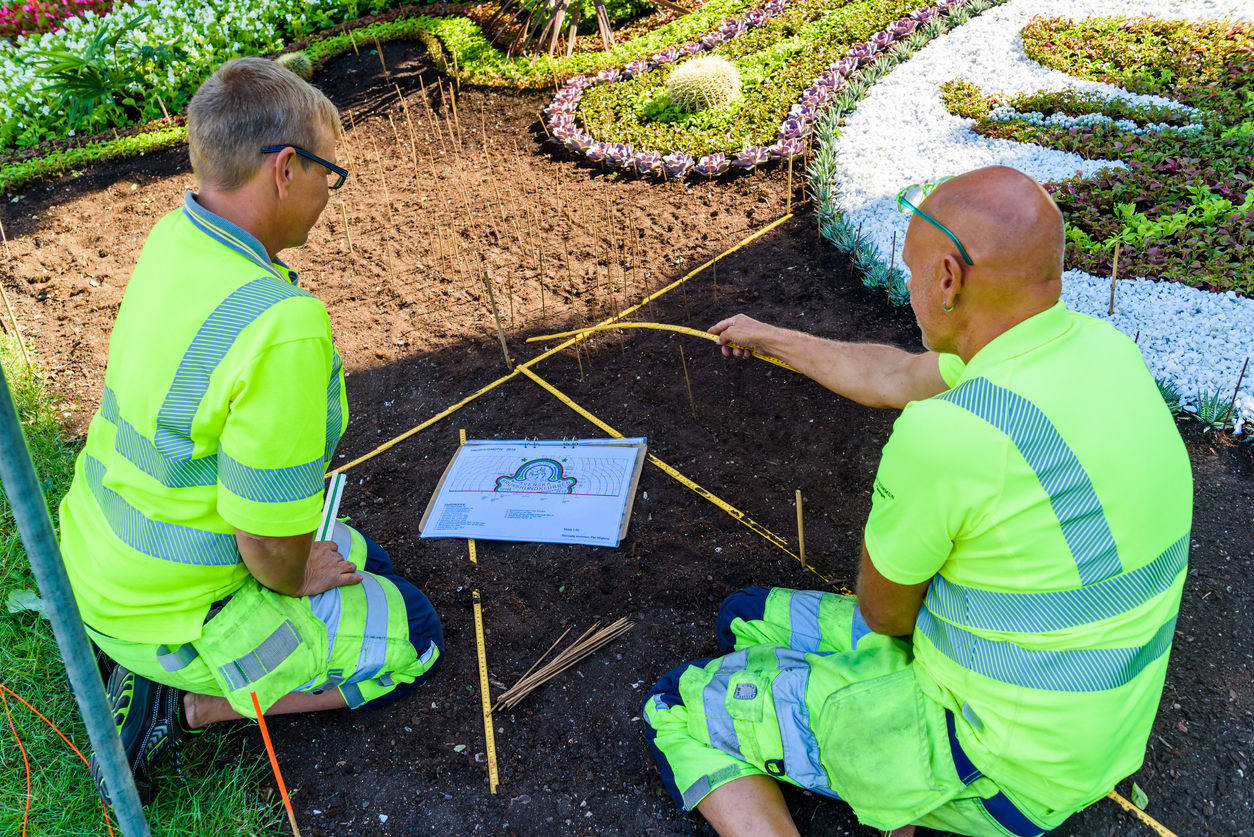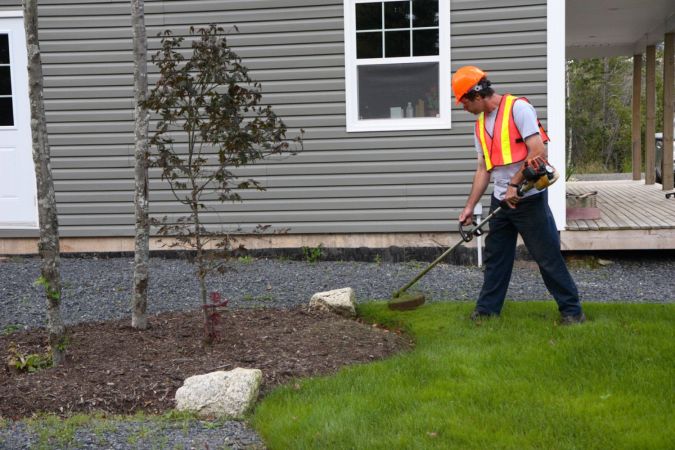We may earn revenue from the products available on this page and participate in affiliate programs. Learn More ›
Whether someone has been working in the landscaping industry for years or has just completed one of the best online landscape design courses and is ready to get to work, starting a landscaping business can be a lucrative venture. According to the U.S. Bureau of Labor Statistics, the average salary for a landscaper is $35,890 per year or $17.92 per hour, but starting a landscaping business can increase earning potential.
With perks like time spent outdoors and beautifying neighborhoods, a landscaping business can offer freedom from a desk job along with monetary gain, but the cost to start a business is not insignificant. Between the expense of tools and equipment and determining what licenses and permits they may need, entrepreneurs will need a comprehensive landscaping business plan, as well as a way to execute it. Aspiring landscapers can follow several steps to help their landscaping business ideas grow into a thriving company.

Before You Begin…
There are several key considerations for aspiring business owners to be aware of to set their landscaping business up for success. Landscaping has many different subsets, including tree care, landscaping and lawn care, landscape design, and installation. Before launching a new venture, entrepreneurs will want to take a look at what’s around already, what businesses have been successful, and what businesses might compete.
Because landscaping is outside work, the climate can be a big factor. Areas with milder winters may have more work year-round, whereas a business launching in a colder climate may need to consider what services can be offered during winter months, such as snow removal and holiday light installation. Once an aspiring business owner has decided which type of landscaping company they want to start, they’ll want to create a business plan that takes into account marketing and growth. Additionally, entrepreneurs will need to find out what types of licenses or permits are required and any associated fees.
Tips for Starting a Landscaping Business
- Decide what area of landscaping the business will specialize in.
- Pursue necessary education, such as online courses or other certifications.
- Determine what business structure to create, such as a limited liability company (LLC) or sole proprietorship.
- Create a comprehensive landscaping business plan including a budget.
- Consult with professionals in the field and business and marketing experts to help the new landscaping business get off to a strong start.

STEP 1: Write a comprehensive business plan detailing the services your business will offer, the equipment you’ll need, your budget, and your plan for attracting and retaining customers.
A business plan is the first step for launching any type of business. This step requires an entrepreneur to conduct market research and make some personal decisions. Landscaping businesses can become highly specialized, so determining what facet of landscaping the business will encompass is essential. For example, the business owner will want to consider whether their company will be a small lawn care business or focus more on tree care. They’ll also want to determine whether it will be a large-scale operation or will emphasize residential garden design. Once it’s been written, the business plan can unfold more accurately. A robust business plan includes what equipment or tools will be required, cost estimates and budget, and a marketing plan.
If this feels daunting, entrepreneurs will want to seek help. “There are many experts that can help you achieve a successful business plan, such as an accountant, attorney, tax planner, banker, business consultant/mentor, and insurance agent,” advises Joe Raboine, vice president of design at Oldcastle APG, an Atlanta, Georgia–based manufacturer of architectural products. “If you have trouble finding these experts, you can ask around your network to see who others recommend. If they are a good fit, you can discuss your strategy and create an action plan, scheduling check-ins to ensure you stay on the path. When they have a vested interest in your success, it’s critical that they understand your goals.”
STEP 2: Name your landscaping business and decide on a business structure.
One of the more enjoyable parts of creating a business is deciding on the name. Landscaping businesses owners often invoke the natural world, flowers, or other gardening elements when choosing a name, or they may decide to simply use their own name. Business owners will want to keep in mind that it’s wise to include words like “landscaping” or “lawn care” to help potential customers understand what the service offers. It may also be a good idea for the owner to obtain a domain name that matches the business name to build a website to advertise the business.
Another key element for an entrepreneur to determine is the business’s structure, which can be a sole proprietorship, partnership, corporation, S corporation, or a limited liability company (LLC). Each of these has different requirements in terms of tax law and structure. The IRS website offers important guidelines to help a new business owner determine the structure. Entrepreneurs can also enlist professional help. For example, if the business will be an LLC, the business owner may want to work with one of the best LLC services, such as LegalZoom or Northwest Registered Agent.
STEP 3: Register your business with your state and get a tax identification number.
The majority of small-business owners will need to register their business name with state and local governments. For an LLC, corporation, or partnership, it may also be necessary for the owner to register in any nearby state where the company will regularly conduct business.
It is generally not necessary to register a business on a federal level. However, paying both federal and state taxes is a requirement. Once a business is registered, the owner can obtain a tax ID number, which is necessary to pay federal taxes, hire employees, apply for any business licenses and permits, and open a business bank account.

STEP 4: Apply for and receive the appropriate business licenses required by your municipality.
There are several different types of business licenses, and the type needed is largely dependent on the location of the business and the industry. It’s important for business owners to familiarize themselves with local laws because operating without the appropriate license or permit could lead to fines and penalties—or even having to shut down the business. Generally, the process of getting a business license starts with an application through the local secretary of state business license office.
In some states, landscapers are required to have a contractor’s license, while in others only a general business license is required to start a landscaping business. Sometimes, a license may not be required to do business, but there are always exceptions. It’s important for any business owner to research and obtain the licenses required to allow their business to operate legally in their jurisdiction.
STEP 5: Get adequate insurance coverage for your landscaping business.
Insurance can be a critical investment for a business. Landscapers frequently work with heavy equipment and materials, tree branches, structures on property, drainage, and irrigation. Having landscaping business insurance can help protect a business in case of an accident, stolen or damaged equipment, or property damage or injury while on the job. Researching the best insurance for lawn care businesses, such as NEXT Insurance or Thimble, can help the owner determine exactly what is needed for their individual business.
The exact cost of landscaping insurance can vary depending on the type of coverage a business needs. For many landscapers, general liability insurance is the minimum, with an average cost of $45 per month. However, the total cost will vary depending on the type and amount of coverage a business owner chooses.
STEP 6: Get your business finances in order.
Starting a business requires some monetary investment up front. Depending on the business plan, more expensive items (such as upgraded equipment or vehicles) can be acquired at a future date. Creating and finalizing a budget, possibly with the help of an accountant, will help any business owner see what type of profit they need to succeed.
Business owners will want to consider accounting software or other business management software to help manage daily operations, such as invoicing and budget tracking. For example, the best lawn care scheduling software programs (such as Jobber) are specifically designed to help with the daily operations of a lawn service business. Opening a business bank account and securing funding as needed are also important parts of setting a business up for success.
STEP 7: Rent or purchase the equipment you need to start your business.
Certain equipment is necessary to start a landscaping business. If the business’s primary goal is to perform landscaping maintenance on established plantings and lawns, the equipment needs may be minimal. If the plan is to launch a commercial landscaping operation, the business may prioritize purchasing larger equipment such as a riding lawn mower. Some equipment, such as rototillers or skid-steer loaders, can be rented on an as-needed basis when a business is first starting out. Many landscapers start their own businesses after having worked in the industry for a number of years and may already have some of the basic equipment. Sara Abbass, owner of Sara Mairead Landscape Design in Northport, New York, advises new business owners that starting out with good-quality equipment can save money in the long run.
“Quality tools are a greater up-front investment, but in the long term are important to complete the work required of the jobsite,” Abbass explains. “Without quality tools, you may need to revisit a jobsite if a client isn’t happy, and that can take up additional hours you could have been meeting with prospective clients.”

STEP 8: Price your services and create a price list to share with potential customers.
Before pricing their services, landscaping business owners will want to research the local cost of landscaping to get an idea of market rates. Networking with other industry professionals can be a great way to stay on top of trends, material costs, and wage trends. Business owners may also want to consider joining an organization such as the National Association of Landscape Professionals to stay abreast of issues that may affect the price of services.
A price list will help potential customers know what to expect before meeting with a landscaper the first time. There are several ways for business owners to price services. A grass-cutting company or lawn and landscape service may price per hour, per visit, per month, or per season. Many of the best landscaping companies offer both recurring and single-visit pricing. For larger jobs, many companies offer free estimates once they’ve visited the site and can estimate the hours and materials required.
STEP 9: Come up with a marketing strategy to help get your business name out in the community.
Marketing is an essential component to drumming up business. Landscapers spend much of their time in the field, but taking the time to have a strong, executable marketing strategy is key to attracting customers. Targeted advertising in the area where the business is hoping to operate can help attract potential customers. In many cases, one of the best website builders for small businesses (like GoDaddy) can help a business owner build a comprehensive website. Abbass also recommends business owners consider hiring the pros. “Professional photographers can be hired to take photos before and after the installation of projects,” she says. “And a professional marketing firm can effectively communicate to your target market, highlighting your past work and services provided. iPhone photos can only take you so far!”
And finally, business owners won’t want to underestimate the power of word of mouth. “I’ve worked in the lawn care and landscaping industry for many, many years now,” says Jeremy Yamaguchi, founder and former CEO of Lawn Love. “Before I started my current company, I did a ton of freelance landscaping work—a lot of which helped me pay for college. So, something that was invaluable for me when starting my own business was taking advantage of all of those connections I had formed as an individual worker. I reached out to all of the people I had done lawn [and] landscaping work for and told them about the company I was starting. Because I had built such positive relationships with my clients, a large percentage of them became my new business’s first clients, and that resulted in a decent initial customer base that allowed my business to make a consistent profit right away.”

STEP 10: Hire and train employees to help grow your business.
While many landscaping businesses may start with a single owner and operator, one person can only do so much. When it comes to scaling a business, hiring and retaining employees is a logical next step. With more people, more jobs can be completed. However, finding the right employees and training them may require a business owner to conduct some industry outreach.
When it comes to finding new hires, Jennifer Nichols, owner of GreenWeaver Landscapes in Lenni, Pennsylvania, supports and participates in industry events and organizations aimed at attracting potential employers to landscaping. “Although wages and benefits have been increasing, the labor market is still very tight,” Nichols says. “So we have been working with Seed Your Future, the movement to promote horticulture and inspire people to pursue careers working with plants. We participate in Green Career Week, promoting green jobs on social media in hopes of attracting more people to the industry.”
From budget to business licenses and arborists to architects, there are a huge number of variables would-be owners will need to consider when hoping to establish a successful landscaping business. Well-researched decisions about the industry will go a long way toward ensuring the success of a business. Following these steps will help set a new business owner on the way to establishing a thriving landscaping business that is both sustainable and profitable, offering any entrepreneur the chance at a long and fruitful career.

















